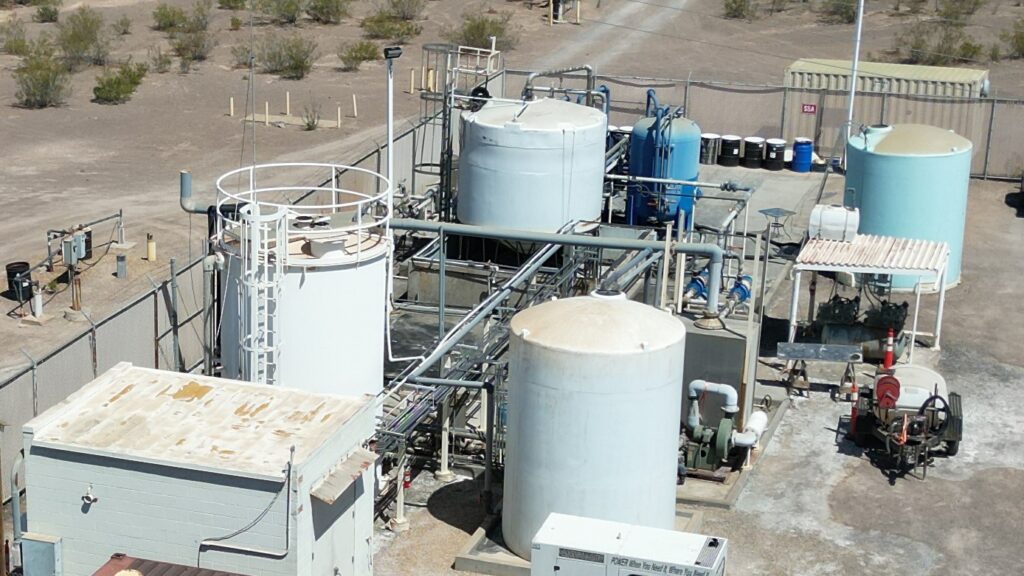Environmental managers are often challenged with balancing a budget for long-term remediation of groundwater. These budgets include both capital expenditures for new systems and system improvements as well as routine operations and maintenance (O&M) of existing treatment systems. Every opportunity to avoid unexpected costs and system downtime of your existing system is an opportunity to allocate resources for the overall program (and avoid a little stress).
In this blog, we’ll look at five inexpensive maintenance tasks that can extend the useful life and reduce overall operating costs of your groundwater remediation system treating chlorinated solvents.
1. Purging Peroxide Piping
When treating for 1,4-dioxane with a Trojan Ultraviolet (UV) Advanced Oxidation Process (AOC) reactor, hydrogen peroxide is injected into the water stream. Between the holding tank and the Trojan reactor, there can be a variety of fittings, pumps, gauges, and flow alarms that can lead to the formation of bubbles within the piping. This excess air in the system causes flow or alarm problems preventing the proper dosage of hydrogen peroxide into the influent water.
It has been observed that this trapped air issue can increase in severity under warmer weather conditions. So, I recommend purging the peroxide piping as the change of seasons brings higher temperatures.
The excess air can be manually removed or “burped” from the flow stream by adding an additional step in the hydrogen peroxide dosage process. One way to purge the peroxide piping is diverting the flow of hydrogen peroxide to a graduated cylinder which acts as a small-scale holding tank. As the pumps pull hydrogen peroxide from the graduated cylinder, the level of hydrogen peroxide in the graduated cylinder will decrease; when the level is low enough the full tank is reopened to the system allowing the trapped air to bubble into the now empty graduated cylinder as it refills.
2. Backflushing GAC Vessels
Granulated activated carbon (GAC) filters are an essential component of treatment systems designed for the remediation of chlorinated solvents.
However, buildup of solids on top of the carbon shortens the useful life of these filters. The solids increase differential pressure between the carbon vessels, leads to flow channeling, and possible early breakthrough since only a portion of the carbon available for contact with contaminants.
In this case, you can avoid cost carbon replacement or filter changeout by backflushing the GAC vessel with potable water. Backflushing breaks apart and flushes out the solid buildup and recirculates the carbon so that water flows through all sections of the carbon particulates achieving maximum contact and more efficient contaminant removal.
To backflush, connect a potable water line to the outlet of the vessel. Redirect the flow through the top of the vessel to a utility tank or other containment system. Flush water through until the flow stream is clear and free of particulates. Then reorient the system to normal operation and check to assure that differential pressure has decreased.
3. Water-Proofing Electrical Components in Vaults
Water and electrical equipment do not go well together. The electrical components utilized to track flows, totals, depths and pressures of extraction and injection wells are often exposed to natural elements. When weather and temperatures vary, condensation in the well vault or rainwater flow into the vault. When water gets into electrical components, it causes them to degrade, malfunction, or stop working all together.
It may just be standard procedure to simply replace these components as they show damage. But, given the current state of equipment backlogs in shipping and manufacturing, it may not always be feasible to keep replacing these parts in a timely or economic fashion. In this case, an ounce of prevention is worth a pound of cure. Covering the equipment with sturdy plastic sheeting will protect it from the weather. A simple covering around junctions, connections or screens can reduce the amount of fluid entering these sensitive locations and can be removed and replaced when access is needed.
4. Regular Maintenance of Off-Site Access Locations
Treatment systems are rarely isolated within the confines of the system compound. Especially as it relates to pump-and-treat systems, there are a multitude of well vaults, monitoring wells, pull boxes, and leak detection ports. Below grade equipment is vulnerable to water damage, biofouling, vegetation growth, and other damages. Leaving these off-site access locations unchecked for too long could lead to unnecessary problems. For example, monitoring wells that are only sampled on a quarterly or semi-annual basis without being maintained in between could show signs of biofouling from rainwater that has leaked through the well cap and/or lid. This could lead to delays in sampling if tubing or electrical components are compromised and require replacing.
To ensure that work is performed smoothly and without outside contamination, make certain your maintenance plan includes preparations ahead of scheduled sampling events and other permit compliance events.
5. Establish Normal Operating Parameters
Taking the time to review historical operating records to establish normal functional parameters helps you proactively identify and remedy operating issues. Document pump speeds, influent/effluent pressure values for various stages, and filter bag differential pressure. These values tend to stay within a fixed range when the treatment system is operating under normal, stable conditions. By understanding these values, one can more quickly identify an area of concern. For example, if an effluent pump is observed to be 58 Hz, when it typically runs between 45-50 Hz, it’s time for an inspection. Check the pump and surrounding pressure gauges to identify if there are anything that could be causing the pump to work harder under unchanged conditions. An early problem identification process can prevent long term malfunction damage or downtime relating to a more serious repair.
Groundwater Treatment System O&M Checklist
All components of a treatment system require maintenance throughout the stages of use. Most maintenance is routine and can be tracked as part of regular O&M. Adding these five simple, inexpensive maintenance items can extend the overall life of the remediation system and reduce repair costs.
Another valuable resource when considering which maintenance items are necessary at a given remediation system is Monitoring and Remediation Wells: Problem Prevention, Maintenance, and Rehabilitation by Stuart A. Smith.
A comprehensive O&M plan can benefit every aspect of the remediation process and should be well considered in advance of the operation of one of these systems. If you’re maintaining a groundwater remediation system treating chlorinated solvents, consider an annual review of your O&M plan. The team of remediation engineers at Hargis offer comprehensive services for operations and maintenance program support for a wide range of on-site remediation systems and technologies including troubleshooting, management and evaluation of data, preparation of regulatory documents, tracking of system operational metrics, tracking permit compliance, verification of health and safety practices, and system optimization. The results can make a significant positive impact on system performance and your budget.
In this case study, a former aerospace manufacturing facility maintained a remediation system for the treatment of volatile organic compounds (VOCs), including trichloroethylene, tetrachloroethylene, and methylene chloride, and the semi-volatile organic compound (SVOC) 1,4-dioxane. Hargis engineers performed a comprehensive evaluation of the existing remediation system’s performance, focusing on finding areas where operational efficiency could be improved. System upgrades and well optimization nearly doubled the system’s runtime and increased contaminant mass removal by 1,500%.
Ready to get started? Connect with us today.
About the Author

Danielle Gallaher, EIT
Staff Engineer
Hargis + Associates, Inc.
dgallaher@hargis.com https://www.linkedin.com/in/danielle-gallaher/
Danielle is a certified Engineer-In-Training and pursuing a Professional Engineering License. She’s been assisting in the operation and maintenance of several groundwater remediation and soil vapor extraction systems throughout San Diego and Orange County since 2021. Her typical responsibilities include collecting samples from treatment systems, interpreting the resulting analytical data, ensuring permit compliance, field site repairs, and cross-training with the hydrogeology department.

